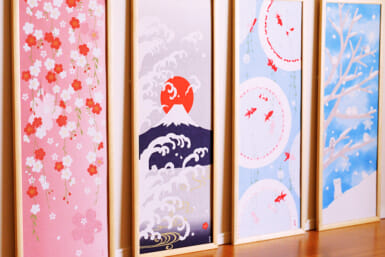Ofuros, sentos, onsen — Taking a bath
Although public bathhouses (sento) and spas (onsen) are acknowledged as places to go to in order to get clean, these establishments have also developed into major social institutions in Japan. More than just a place to wash away the day’s dirt, they cater for the weary salaryman, gossiping grandmothers or local tradespeople anxious to exchange information. Immersion in the hot, steaming waters is the closest we mortals may come to regeneration. “I go into the bathhouse a pessimist and come out an optimist,” confided one Japanese.
The custom of bathing as we know it in Japan has been around for about 1,000 years. Originally part of a purification ritual in Buddhist temples, it probably owes its existence to ancient Chinese medicine texts, which espoused the virtues of hot springs and the curative powers of the minerals contained therein. Eventually, as the benefits of bathing became recognized, the local people were permitted to avail themselves of the temple bath. Wandering monks also did much to spread the practice of bathing. Whether this was for purely altruistic reasons or for material gain is unknown, but to this day, many spas and hot spring resorts still bear the name of the monk who first discovered them.
With such origins and such a long history, it is natural that bathing should have developed its own peculiar etiquette, its own set of rules.
Up until recently, for example, there was a strict order for taking a bath. First came the master of the house, then the male children in descending order of age, followed by the female members in descending order of age. In some households, if there were male servants, even they preceded the female members. It was also a custom to offer one’s bathing facilities to those neighbors without a bath, because until the post-war period, very few homes were equipped with a private bath. Guests were always offered first use of the bath.
Today, this custom is still followed. For those foreigners who find themselves in this situation, it is always preferable to be armed with some rudimentary knowledge. I say this because, even after all these years, stinging shame and creeping horror still return when I recall how I took my first Japanese bath. It was at a private residence and, sure enough, I climbed into the tub, lathered myself luxuriantly and, at the end of it, let out the water, a ring of soapy grime no doubt still clinging to the walls of the cedar wood tub. Although the Japanese host would never let his horror be communicated, you can be sure it confirms the theory that foreigners are barbarians after all.
Conversely, there is the story of the Japanese who finds himself the guest of a Japanese couple living in New York. Confronted with a bathroom lacking a drainage hole, he nevertheless takes his bath Japanese-style, while the Japanese hostess stands grimly but silently outside the bathroom door, furiously mopping up the ensuing flood. Again, nothing is said, but total oblivion to local customs tends to color one’s feelings towards one’s guest.
Therefore, in a private residence, lather outside the tub, rinse off and only when you’re sure of being squeaky clean, enter the bath. You may find the tub filled to the brim. It’s perfectly all right to scoop some of this water off and use it for washing. Most foreigners feel somehow guilty at the great overflow they produce upon lowering themselves into the bath, so this is a good way to avoid the uncomfortable feeling that someone has heard the great tidal wave.
If the bath seems too hot, rather than adding gobs of cold water, just refrain from getting in. Remember, the Japanese like their bath boiling hot. So, this will help enormously in impressing your hosts as to your endurance, which is high on the list of Japanese virtues, for they will assume you entered the scalding waters. I sometimes speculate that Japanese baths are made especially hot for foreigners. If asked, just smile secretively, nod slowly and confide that you found it a bit on the cool side. This is guaranteed to raise your esteem dramatically in the eyes of your host.
If, however, you managed to lower yourself into the cauldron without producing blisters, resist the temptation to spend the night there, for all the household members are still to follow. After you clamber out, put the boards back on the tub to prevent the water from cooling down.
One tip. If you’re a guest or traveling, don’t immediately holler for a western-style bath towel. Try to adopt the practice of the natives — use the tenugui (small hand towel) both for washing and later, well rinsed and wrung out, for drying. It’s a marvellously practical item that will usually dry out overnight, is compact, and can be used for a variety of purposes.
Public bathhouses (sento) require a bit more ingenuity, for all of you is on public display. Lockers are provided just inside the curtained doorway for your shoes. The cashier, who has an untrammelled view of both sections of the bathhouse, may be of either sex. Don’t panic, don’t flinch. Calmly undress and cover your lower parts discreetly with your tenugui as you enter the bathing area. Again, resist the temptation to haul in a huge bath towel. Follow the same procedure as you would in a private bath, except don’t scoop out the bath water. Just use the tap water provided. If you’re with people you know, it’s considered good form to offer to scrub a fellow bather’s back. Menstruating women should refrain from entering the tub.
At ryokan where you have to use a communal bath, spas, minshuku, etc., you will find that most Japanese take their bath before the evening meal. For some reason, later-night bathing, which many foreigners prefer, seems to disconcert the management. It’s perfectly all right to arrive at the dinner table with wet, straggly hair and to shuffle around the rest of the evening in what amounts to nothing more than a dressing gown. This practice, along with segregated bathing, was adopted around 1865 as a Japanese concession to outraged western morals. Until then, people simply walked home naked after taking their bath.
Mixed bathing occurs at a few hot spring resorts. And if you’re staying at a company besso (villa), you may come across a whole family taking a dip together. Don’t be alarmed that you’ve run into some kinky group. Communal family bathing is quite a common practice, at least until children reach puberty.
A warning, though. Those foreigners that master the few rules associated with Japanese-style bathing and overcome their reluctance to bathe communally, quickly become converted for life. Few will be content with their former habit of wallowing in their own dishwater. Some will search in vain for sento overseas. Others will find themselves compelled to take the approach of the Japanese guest in New York.








